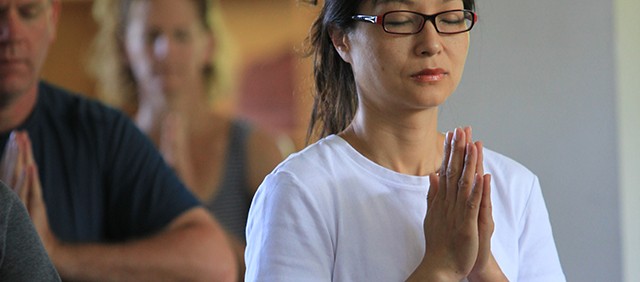How Mindfulness Can Make Us Happier and More Effective at Work

According to the Bureau of Labor Statistics, we’re now spending more time working each week than we do sleeping — although both of those activities may be happening in the same place these days.
With all that extra time on the job, we ought to be getting more done than ever before. From the outside, it certainly looks like we’re busy enough: the typical office worker gets 122 emails, switches tasks on the computer 566 times, and touches their phone 2,617 times a day. All told, we’re face to face with a screen for 11 hours out of the average day.
Yet in that sea of technology and information, many of us aren’t waving but drowning. For starters, there’s the 1 million people who miss work every day due to stress. Then there’s the 66 percent of us who find our work unengaging and unmotivating. That stress and disengagement means that while the quantity of our work escalates, the quality of all that time we’re putting in often plummets.
Part of the challenge to our productivity comes from a mind that simply struggles to sit still. A 2010 Harvard study by Matt Killingsworth and Daniel Gilbert found that our minds are wandering away from what’s happening in the present moment a whopping 47 percent of the time. Even more striking, when our minds are wandering, we tend to be less happy than when we’re focused on the here and now.
While we may all be a little predisposed toward distraction, the demands of today’s work can turn that distraction into an almost perverse art form. Take, for example, multitasking—a life “skill” I’m willing to bet is on your résumé and almost certainly in your job description. We multitask to handle the stress of too much to do, yet it paradoxically increases biomarkers of stress in the body. And to top it all off, the more we do it, the worse we get at it. Stanford research led by Eyal Ophir found that the most frequent multitaskers felt they were the most productive but actually scored the lowest in the lab and showed a greater propensity toward distraction. “We kept looking for what they’re better at, and we didn’t find it,” she said.
All of which begs the question of what we can do to give ourselves a fighting chance at working in a way that’s engaging and effective. In Kripalu’s evidence-based resilience program, RISE, one of the key tools we use to help workers in high-stress fields perform well is mindfulness. By training the mind to pay attention to the present moment, on purpose, with an attitude of openness and nonjudgment, mindfulness fosters our ability to focus awareness and redirect it to the things we value.
And the good news is that you don’t have to quit your day job and become a monk on a mountaintop in order to reap its benefits. Multiple studies, including one right here at Kripalu with RISE participants, have found that even a brief experience of mindfulness practice over a few days improves attention and self-regulation, meaning we’re better able to put attention where we need it, and keep it there when distractions pop up. Keep it up, and a mindfulness practice may even start to change your brain: a neuroimaging study observing participants in an eight-week mindfulness meditation course found that areas of the brain associated with self-regulation and learning actually grew denser gray matter throughout the training course, meaning these skills were becoming more efficient and responsive.
But getting the mind to stay put in one spot is just one piece of the productivity puzzle. All the focused attention in the world won’t get us very far if we’re totally overwhelmed with all the stuff piling up on our plate. When it comes to dealing with the demands of the day, the same tools of yoga and mindfulness can support us in managing our stress more skillfully. One study at Kripalu found that after a five-day RISE workshop, participants reported a 32 percent reduction in perceived stress—a change that lasted two months beyond the program, when our researchers next checked in.
In meditators who keep up their practice over time, the brain begins to adapt and change the structures of the stress response—the same researchers who found mindfulness practice growing our gray matter also noted that after a sustained meditation course, the amygdala becomes smaller, which translates into a mind and body that are less reactive to stressors, and better able to respond to challenges without being hijacked by the fight-or-flight response.
Taken together, these tools can help us show up to work in a way that is calm, clear, and connected to the things that matter most; less rattled by the waves of the workplace; better able to weed out distractions; and set up to get the job done. Oh, and by the way, all that sleep we’re not getting because we’re all working so much—guess what? The research is in: meditators sleep better, too.
Sam Chase, MFA, E-RYT, author of Yoga and the Pursuit of Happiness, holds certificates in yoga and positive psychology from Kripalu and a master’s degree from Harvard.
Full Bio and Programs
